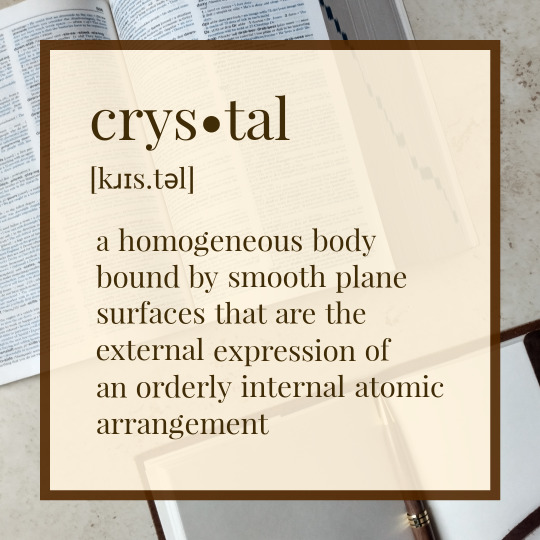Text

Do you ever just stumble upon a word that perfectly describes some aspects of your life? I did.
Initially, I discovered this word while looking up the definition of tarnish. Being the curious type, whenever I open up a dictionary, I typically spend anywhere from 5 to 50 additional minutes just reading the dictionary. Since tarry is just a couple definitions lower than tarnish in my dictionary, I read it along with others.
Immediately I loved it. Its definition is short and straightforward, but its meaning struck a chord with me. It perfectly captures my (now stereotypical) tendency to stay with a task or in a place despite knowing that I should move on. For some reason unknown to me, a fast transition from one thing -or one place- to another feels too abrupt. I prefer a slower pace. It feels more deliberate and certain to me.
SaroSaguaro.etsy.com
0 notes
Text


Today is the first lesson on crystallography!
This time around I wanted to start off right by defining some important terms we will use throughout the crystallography section.
Crystallography is the study of crystals which includes natural and synthetic crystals. Remember that a mineral must be the product of natural processes; therefore, the complete scope of crystallography extends beyond the bound of minerology.
A crystal is a homogeneous body bound by smooth plane surfaces that are the external expression of an orderly internal atomic arrangement. This definition means a crystal (1) has faces and (2) has an orderly structure on an atomic level.
Crystalline is the adjective used by mineralogists to describe materials that have orderly internal atomic arrangement, but no faces. Although we will be utilizing the above nomenclature, it is also beneficial to know that physicists use "crystal" to mean any substance that has an orderly internal atomic arrangement regardless of whether or not the substance has faces. They also use additional terms to capture the nuances of crystals. A crystalline solid with well-formed faces is called "euhedral". If the same solid has imperfectly formed faces, it is called "subhedral", and if it has no faces, it is called "anhedral".
There are more terms we will need for further study of crystallography, but since this post is already vocabulary dense, I will define them next week - in sha Allah.
SaroSaguaro.etsy.com
0 notes
Text

Our word this week is tarnish.
As a verb it has two meanings, and, although the second definition is a clever use of language, the first definition is our focus today.
Many metals tarnish. Silver, aluminum, and copper are well known for their tendency to tarnish. A metal tarnishes when a thin layer of corrosion develops on the surface of the metal. A common cause of tarnish is oxidation (ie. when oxygen in the surrounding environment reacts with the metal). Certain conditions like excessive moisture and extreme temperatures can accelerate this process.
What can you do to minimize tarnishing? Well, you can:
~ store your metals in a cool dry place
~ utilize anti-tarnish products (ie. anti-tarnish bags and anti-tarnish strips)
~ gently clean your metal with soft cloth and mild detergent
~ avoid exposing your metals to harsh chemicals and acids
(Fun fact: one college building in Minnesota has giant copper panels on one of its exterior walls. I didn't understand why the designers decided to use untreated/uncoated copper until I saw the copper panels thoroughly tarnished. The unique blue green shade of tarnished copper was the perfect accent for the building's exterior.)
SaroSaguaro.etsy.com
0 notes
Text


A couple weeks ago, I jumped the gun. I was so eager to start the Introduction to Mineralogy series that I totally forgot to define what a mineral is. To rectify that, today's lesson will be on the technical definition of a mineral.
Our textbook definition is: a naturally occurring chemical element or compound formed as a product of inorganic processes.
Let's break that up a little bit.
NATURALLY OCCURRING
A mineralogist studies not only minerals, but also the processes (geological, chemical, etc.) that allow those minerals to form. The definition of mineral excludes materials derived from raw minerals. Materials such as steel, cement, plaster, and glass are not minerals. Additionally, a mineral cannot be man-made. For this reason synthetic rubies are not minerals despite the fact they are chemically, structurally, and physically the same as natural rubies.
*This is not to say that synthetic gemstones are not worthwhile. They are "real" gemstones. Synthetic gemstones are often more reasonably priced, have richer color, and fewer inclusions than their natural counterparts.*
CHEMICAL ELEMENT OR COMPOUND
Some minerals exist as single, independent elements. Gold and silver are perfect examples of this. Their chemical formulas are Au and Ag, respectively. Minerals can also exist as multi-elemental compounds as long as the crystal structure is consistent and could (theoretically) extend indefinitely in a regular geometric pattern. Quartz is a common chemical compound mineral, and its chemical formula is SiO2. (The 2 should be subscripted, but I cannot do that on this device.)
Naturally, this part of the definition necessitates that a mineral must have a chemical formula which is electrically neutral (ex. not just some collection of charged ions). Additionally, minerals cannot be mechanical mixtures, regardless of the uniformity.
FORMED AS A PRODUCT OF INORGANIC PROCESSES
Mineralogy does not include materials that are the result of plant or animal life. Even though they occur naturally in the Earth's crust, coal, oil, amber, and animal bones are not minerals. Pearls, mother of pearl, other shells, and corals are not minerals.
SaroSaguaro.etsy.com
0 notes
Text


When it comes to words, obsolete really just means underappreciated.
Last week's #wordwednesday words should have been overmorrow and ereyesterday. While both of these words have fallen out of use in English, they have cousin words with similar meanings German and Dutch, respectively. I honestly see no reason not to start using them again.
You may have a very reasonable objection not to use these words. After all, most people are probably not going to understand these words without a definition provided. Don't let that stop you. Language change can, and does, happen.
In sociolinguistics, we talk about two major forces that shape language use. On the one hand, every language has set grammar and pronunciation rules. Any speaker who wants to be well understood must follow these rules. This is called structure. On the other hand, every speaker is an individual. Every utterance (or text) is a reflection of the speaker's unique identity, and speakers choose the Language they use to communicate. This is called agency.
While I have set up structure and agency to be opposing forces, the reality is that they influence each other, too. Every speaker agent has to navigate social and linguistic structure. For instance, social structures determine if a speaker should use formal or informal language, and linguistic structures determine how noun-verb agreement manifests itself. Importantly, speakers can choose to either adhere to or oppose existing social and linguistic structures. When enough speakers choose to oppose the existing structure in the same way, they CHANGE that structure - social or linguistic.
Be agents of positive change.
SaroSaguaro.etsy.com
2 notes
·
View notes
Text
New Series

Today we are kicking off a new series called Factual Friday.
I am interested in covering some of the basics of Mineralogy with all of you. This knowledge is useful not only for me as a gemstone jewelry designer, but also for you. It is important that you make informed decisions about your mineral specimens, gemstone jewelry, blasting sands, industrial abrasives, etc..
Mineralogy has historically been broken into three major facets: crystallography, physical mineralogy, and chemical mineralogy. We will look at each of these facets in greater detail in the future, but for now we will simply say that crystallography is the study of crystal structure - specifically the faces and their angles. Physical mineralogy focuses on the tangible, observable aspects of a mineral (eg. color, specific gravity, etc.). Chemical mineralogy acknowledges that minerals are chemical compounds and is primarily based on laboratory testing to determine and/or describe the composition of minerals.
0 notes
Text

This is the first definition of what I hope will be many. As I mentioned in my introduction, I want to share a word every week - every Wednesday to be specific. Every Wednesday will be Word Wednesday for SaroSaguaro, in sha Allah. (I know today is not Wednesday, but just roll with it because in the future, these definitions will be on Wednesdays.)
If you have word suggestions, please leave them below. I am so curious which words you choose.
Additionally, if you are up to it, I would love to read your example sentences. Here's mine: he introduced himself as a doyen of Arabic poetry.
0 notes
Text

Tiger's eye was discovered in 1784 by Francois Levaillant, or was it?
In the gem and mineral world, the standard narration of the discovery of tiger's eye is something like this: "In 1784, on the banks of the Orange River in South Africa, Francois Levaillant saw what he had never seen before - a brown pebble with a brilliant, golden colored belt."
Alright, I am willing to believe that 1784 is the first time a EUROPEAN discovered an AFRICAN variety of quartz in what is now South Africa. What I find extremely hard to believe is that this instance, in 1784, is the first time a HUMAN ever discovered the stone. If that were true, it would mean that no AFRICAN had encountered tiger's eye -EVER- despite the fact that the stone exists in relative abundance and African peoples had been utilizing the Orange River centuries before Mr. Levaillant left Europe.
In reality, what we are looking at has two facets. Firstly, it seems that tiger's eye was not culturally significant to the African peoples around the Orange River. I will stress, however, that cultural insignificance does not necessitate that the stone had never been seen. Secondly, Mr. Levaillant's account of tiger's eye is well documented. He wrote about his "discovery" in his traveling journal. He also brought the first known sample of tiger's eye to Europe.
These facets, when taken in combination with political colonialism and social Darwinism, make it all too easy for Westerners to overestimate their importance in the discovery of tiger's eye. To be more careful, we should say that the first written record of tiger's eye is from Francois Levaillant's travel journal which he recorded while exploring the Orange River in 1784.
SaroSaguaro.etsy.com
0 notes
Text

Hello everyone,
My name is Ariel. I am a Muslim and a mother of four children. I have two Bachelor's degrees: (1) Linguistics and (2) Middle Eastern and North African Studies.
The purpose of this blog is to pursue three of my passions, so if you are interested in semantics, minerology and gemstones, and jewelry making, (especially needlework), stick around. In sha Allah, this is the blog for you.
1 note
·
View note